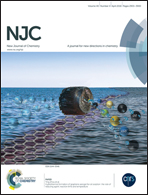A sensitive phosphorescence method based on MPA-capped Mn-doped ZnS quantum dots for the detection of diprophyllin†
Abstract
A new strategy for diprophyllin (DPP) detection was developed by utilizing room-temperature phosphorescence (RTP) of MPA-capped Mn-doped ZnS QDs. Upon the addition of diprophyllin, the phosphorescence intensity could be regularly quenched with the increase of diprophyllin and a linear relationship could be observed in the range of 1.97–197 nM with the limit of detection (LOD) of 0.893 nM. The phosphorescence quenching mechanism was preliminarily ascribed to electron transfer from photo-excited Mn-doped ZnS QDs to DPP that was used as an electron acceptor. Upon induction from Mn-doped ZnS QDs to diprophyllin, the electrons were able to cause significant phosphorescence quenching of Mn-doped ZnS QDs. This room-temperature phosphorescence system for diprophyllin detection is label-free, convenient, sensitive and selective, which can be used to detect diprophyllin in real samples.


 Please wait while we load your content...
Please wait while we load your content...